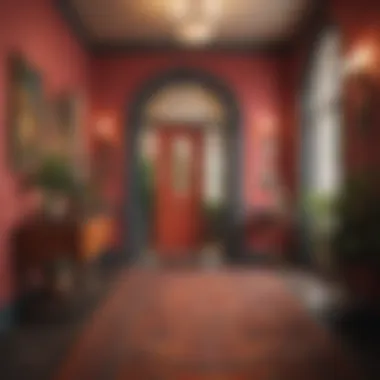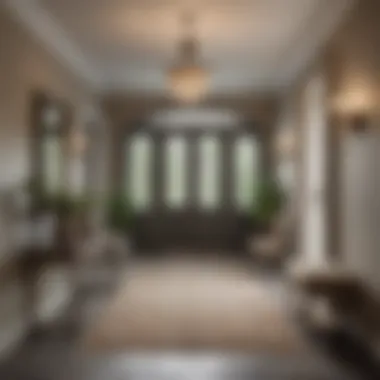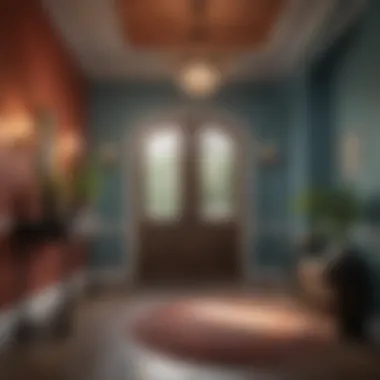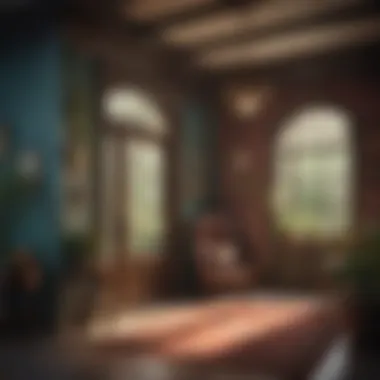Choosing Colors for Your Entryway: A Comprehensive Guide


Intro
The entryway is often the first area of a home that guests encounter, setting the tone for their entire visit. Choosing the right colors for this space is crucial. The colors you select can shape perceptions, evoke emotions, and convey personal style. In this guide, we will navigate the complexities of color choice in entryway design, examining various color schemes and their psychological implications. We will also consider practical factors such as lighting and space dimensions, ensuring a balanced and inviting atmosphere.
Design Inspirations
Inspiration for color schemes can come from various sources. Understanding current trends and established color palettes can be beneficial. Let's explore these areas in more detail.
Trending Styles
Current trends reflect a shift towards warmer tones and earthy palettes. Neutrals, such as soft beige or taupe, create a clean foundation, allowing for accents that can be easily changed over time. Additionally, bold colors like deep teal and warm mustard are gaining popularity, enabling homeowners to express personality right from the entryway. Consider the following:
- Warm Neutrals: These foster comfort and a welcoming atmosphere.
- Bold Accents: Use sparingly to highlight unique features or artwork.
- Natural Inspirations: Colors drawn from nature often create a soothing environment.
Color Palettes
Selecting a cohesive color palette is essential to achieving a unified look. A well-thought-out palette enhances both aesthetics and functionality. Here are a few effective palettes:
- Monochromatic: Variations of a single color can create sophistication and calmness. For instance, a range of blues can embody tranquility.
- Analogous Colors: These sit next to each other on the color wheel, such as green, blue, and yellow. This blend offers harmony and subtle contrast.
- Complementary Colors: Pairing opposites can energize the space. A bright coral against a deep blue can make a bold statement.
"The choice of color can impact mood and perception, making it an important aspect of entryway design."
Maintenance and Upkeep
Once you have selected your colors and designed your entryway, maintenance is key to preserving that initial impact. Regular upkeep can ensure that the entryway remains inviting and visually appealing over time.
Seasonal Maintenance Checklist
- Inspect for Wear: Check for chip paint or fading, particularly in high-traffic areas.
- Repaint if Necessary: Touch up areas that show signs of wear to maintain aesthetic integrity.
- Seasonal Cleaning: Dust surfaces and clean floors to keep the space looking fresh.
Cleaning and Organization Tips
Maintaining organization can enhance the appearance of your entryway. Here are some tips:
- Utilize baskets or bins for storage to control clutter.
- Incorporate hooks for coats and bags, keeping them off the floor.
- Regularly evaluate and remove items that are not essential.
By adhering to these guidelines, homeowners can ensure that their entryway remains an attractive and functional first impression. The choices made in color selection and maintenance directly contribute to the overall vibe and character of the home.
Understanding the Importance of Entryway Colors
Choosing the right colors for your entryway serves not just an aesthetic purpose; it has practical implications on how your home is perceived. The entryway is the first space guests encounter, setting the tone for the rest of the home. A well-designed entryway welcomes visitors and provides a glimpse of the personality within. Conversely, a poorly executed color scheme can create feelings of discomfort and confusion.
The colors chosen can influence mood and create memorable experiences. Hence, understanding the importance of entryway colors is crucial for homeowners and design enthusiasts alike. It’s an opportunity to express individuality while ensuring a cohesive look with the rest of the home.
Role of the Entryway in Home Design
The entryway is often considered the heart of a home. It is the transition area between the outside world and the interior. Many homeowners do not invest enough thought into this space, but it should be a reflection of the overall design philosophy. An entryway’s design unites various elements of a home, including style, ambiance, and color.
With effective color selection, an entryway can create a sense of openness or warmth. For example, lighter colors generally make a small space feel larger and more inviting. Darker tones might add a touch of sophistication but could potentially make a narrow space feel constricted if not balanced with light fixtures.
Furthermore, the entryway has practical functions. It often accommodates shoes, coats, and other items, demanding that aesthetic choices consider functionality. Overall, understanding the role of the entryway equips homeowners and designers to craft spaces that are both beautiful and useful.
Psychological Effects of Color Choices


Colors possess psychological impact and can evoke various feelings. For instance, blue tones are calming and promote tranquility, making them suitable for spaces intended to offer respite. On the other hand, red can provoke energy and urgency, which may be overwhelming in an entryway but effective if balanced with softer shades.
Research has shown that certain colors can influence emotions and decision-making. For visitors, the entryway serves as an introduction to the overall vibe of the home. A harmonious color scheme can lead to feelings of peace, security, or excitement, depending on the choices made.
Color theory suggests that different hues affect people differently, emphasizing the need for thoughtful selection. Choosing entryway colors involves more than visual appeal; it requires a deep understanding of human psychology and the desired emotional response. It ultimately allows for more intentional design that resonates both with homeowners and their guests.
Key Considerations When Choosing Colors
Choosing colors for your entryway involves various factors that can affect both the visual appeal and the emotional resonance of the space. It is not just about picking a color you like; rather, it encompasses understanding how that color interacts with lighting, the space itself, and adjacent areas. Making thoughtful decisions can greatly influence the atmosphere and first impression of your home. In this section, we will outline key considerations that should inform your color selection process.
Assessing Lighting Conditions
Lighting is a crucial element that can transform how a color appears within a space. Natural light, fluorescent, and incandescent lighting all cast different colors and intensities, which can drastically change the perception of your chosen paint hue. For instance, shades of white can appear cool or warm depending on the time of day and the type of lighting present.
To assess the lighting conditions in your entryway, observe the space at various times throughout the day. Take note of how sunlight spills into the area. Dark colors may absorb more light, potentially making the space feel smaller or more enclosed. Conversely, lighter colors can reflect light and create a more open and airy environment. Testing paint samples on different wall sections can provide valuable insight into how colors behave under the fluctuating lighting conditions.
Evaluating Space Dimensions
The dimensions of your entryway are another vital factor in your color selection process. A cramped or narrow entryway typically benefits from lighter tones to create a sense of spaciousness. The use of light and airy colors, such as soft whites or pale pastels, can visually expand the area.
On the other hand, larger entryways can accommodate darker and more saturated hues without feeling overwhelming. These darker colors can add a touch of sophistication and intimacy. However, balance is key; ensuring that the chosen colors align with the spatial dimensions and architectural features of the entryway is crucial to achieving a well-designed outcome.
Harmonizing with Adjacent Rooms
Your entryway acts as a transitional space between the outdoors and the inner sanctum of your home. Therefore, it is essential to harmonize colors with adjacent rooms to create a cohesive flow. The goal here is to choose colors that complement rather than clash with the palettes of nearby spaces.
Consider the colors and themes present in neighboring rooms. If your living room has warm tones, you might want to choose an entryway color that either carries those tones into the entry or serves as a subtle bridge. Conversely, if the adjacent areas are more subdued, a bold entryway color can serve as a focal point while still feeling connected to the overall design.
"Color choices in one space can reverberate through the home, establishing a mood and tone that enhances the entire environment."
In summary, evaluating lighting, understanding spatial dimensions, and harmonizing colors with adjacent rooms are critical steps in the process of selecting entryway colors. Each element interplays to create a welcoming and aesthetically pleasing entry point that reflects personal style and enhances the overall ambiance of the home.
Popular Color Schemes for Entryways
Choosing an appropriate color scheme for your entryway is a critical part of home design. This space serves as the first impression for visitors, setting the tone for the rest of the home. A well-thought-out color choice can create a welcoming atmosphere and reflect your personal style. There are several popular color schemes that homeowners can consider, each offering unique benefits and considerations.
Neutral Tones for Timeless Elegance
Neutral tones are highly sought after for their timeless appeal. They provide a sense of calm and blend well with various decor styles. Whether you choose shades like beige, gray, or taupe, neutrals create a versatile backdrop. These colors make it easy to incorporate contrasting decor elements such as artwork or furniture.
In addition to flexibility, neutral colors tend to expand the space visually. For smaller entryways, this can create a sense of openness. Neutrals are also great for showcasing textures like wood or metal, allowing you to experiment without overwhelming the senses.
When selecting neutral tones, consider the lighting in your entryway. Natural light can drastically alter how a color appears. Subtle differences in undertones may also affect your choice. For instance, a warm beige can feel inviting, while a cooler gray might offer a modern edge.
Bold Colors for Visual Impact
Bold colors can dramatically influence the aesthetic of an entryway. A rich navy blue or an intense red can capture attention and make a statement. Choosing a bold color can emphasize your personal style and capture the essence of your home. It is important to consider how these colors impact mood; for example, warm tones are often associated with energy, while cool tones can promote tranquility.
However, going bold requires careful consideration of associated decor. You want the color to influence the space positively rather than overpower it. Consider pairing bold walls with neutral furnishings to achieve balance.
A good practice is to choose one wall as a focal point. This approach can draw the eye and offer a vigorous contrast without overwhelming the entire area.
Pastels for Soft Cohesion
Pastel colors are increasingly popular for homeowners looking to create soothing environments. Soft shades like mint green, pale yellow, or murky lavender can evoke feelings of relaxation and cohesion. These tones are especially effective in transitional spaces, easing the transition between rooms.


Pastels often work well with natural light, creating an airy feel that enhances openness. These colors can also be beautifully layered with various textures and materials. For instance, a pastel wall paired with wooden elements creates warmth and charm.
Moreover, pastels can serve as a versatile base for more vivid accessories and art, allowing for personal expression without compromising neutrality. With pastels, you can strike a delicate balance between subtlety and vibrancy, making it easier to adapt if style changes in the future.
Key Takeaway: When choosing colors for your entryway, consider how each scheme reflects your personal style and meets practical needs.
When planning your entryway color scheme, consider mixing elements from each category. Creating a harmonious blend can result in an inviting and visually appealing space.
Incorporating Texture and Patterns
Incorporating texture and patterns in the entryway is essential for creating visual interest and depth. These elements enrich the space and can significantly influence the overall ambiance. Texture can change how light interacts with your walls, while patterns can draw the eye and establish a theme. For homeowners and interior design enthusiasts, careful consideration of these features can transform a simple entry into a captivating introduction to the home.
Textured Walls: Enhancing Depth
Textured walls can provide a layer of complexity to an entryway that flat surfaces cannot achieve. Using finishes such as plaster, wood paneling, or even fabric can give dimension to the walls. For example, a slightly roughened stucco finish often creates shadows that add depth to the space. This effect can make an entryway feel warmer and more inviting.
It's crucial to consider how these textures catch light. A glossy finish may reflect light and brighten the space, while matte finishes absorb it, creating a cozier atmosphere. Additionally, choosing textures that harmonize with surrounding elements is key. For instance:
- Natural textures, like wood or stone, can evoke a sense of calm and connection to nature.
- Metallic finishes can lend a modern touch, enhancing contemporary decor.
Patterned Accents: Adding Interest
Patterns are another effective way to incorporate visual intrigue in an entryway. Whether used in wallpaper, area rugs, or decorative tiles, patterns can enliven a space and guide the eye through the design. Incorporating accents, like a bold patterned runner, draws attention and can serve as a focal point as you enter.
When choosing patterns, consider balance and coherence. Mixing different patterns is possible but must be done thoughtfully. Here are some practical tips:
- Select a dominant pattern that will inform your design choices. A large geometric pattern can dominate, while smaller prints can complement it.
- Maintain a color scheme. Patterns should keep within the palette of the entryway to avoid visual confusion.
- Layer patterns through textures. Combining a patterned rug with a simple textured wall can create depth without overwhelming the space.
In summary, incorporating texture and patterns can significantly enhance your entryway’s aesthetic. Textures can create depth and differentiate surfaces while patterns add layers of interest and character. This thoughtful design strategy will ultimately invite guests into a space that feels both warm and timeless.
"Carefully chosen textures and patterns lead the way in communicating personal style and creating a memorable entryway."
Ultimately, understanding these elements transforms the entryway into a significant workshop of design creativity.
Cultural Influences on Color Selection
Understanding how cultural influences shape color selection is critical in creating an entryway that resonates with personal and communal identities. Colors carry different meanings in various cultures, affecting individuals' interpretations and emotional responses. This section will explore such significance and its impact on designing welcoming spaces.
Understanding Cultural Color Significance
Different cultures assign various meanings to colors, which can inform one’s choices when selecting hues for an entryway. For instance, red is often seen as a symbol of luck in many Asian cultures, while in Western contexts, it may represent passion or caution. Similarly, blue can signify calmness and tranquility in some societies, while in others, it may signify sadness.
It is essential to understand this significance when choosing colors for an entryway, as they work not only as visual elements but also as communicators of cultural narratives. By recognizing these meanings, homeowners can create environments that align with their values and those of their guests. This awareness can enhance the overall atmosphere, making the entryway feel more inviting and thoughtful.
"The color in your entryway reflects not only your aesthetic tastes but also your cultural understandings and personal expressions."
Incorporating Personal Heritage into Design
Incorporating personal heritage into entryway design can offer profound satisfaction and connection. Homeowners can draw inspiration from traditional color palettes that resonate with their ancestry. For example, Mediterranean designs often use vibrant colors, such as terracotta or deep blue, which may reflect the local landscape and cultural history.
When selecting a color scheme that respects one's personal heritage, here are some factors to consider:
- Identify cultural colors: Determine colors that hold significance in your culture. This may involve researching traditional art, textiles, or architecture.
- Blend with modernity: Integrate heritage colors with contemporary trends. This balance creates a unique design, incorporating the past while looking towards the future.
- Create personal meaning: Use specific colors that hold personal memories or associations. This will create a deeper emotional connection to the space.
Sustainable Choices in Entryway Colors


When selecting colors for your entryway, the significance of sustainability cannot be overstated. Homeowners today are becoming increasingly aware of their environmental impact. They want to create a beautiful and inviting space while also being conscious of the ecological footprint left behind. Consequently, sustainable choices in entryway colors not only enhance the aesthetics of the home but also contribute positively to the environment. Understanding the various options available, such as eco-friendly paints and natural materials, is essential for making informed decisions in this regard.
Eco-Friendly Paint Options
The market now offers a range of eco-friendly paint options that align with sustainable living principles. These paints are typically water-based, low in volatile organic compounds (VOCs), and free from harmful chemicals. By choosing eco-friendly paints, homeowners can ensure that they are not exposing themselves or the environment to toxic substances. Some worthy options include:
- Milk Paint: A natural choice made from milk protein, lime, and natural pigments, which is biodegradable and safe for indoor air quality.
- Clay Paints: Volcanic ash and clay create a non-toxic paint that gives a unique matte finish.
- Natural Oil Paints: Made from natural oils like linseed, these provide a durable finish without harmful chemicals.
Opting for these environmentally friendly paints allows for a variety of colors and finishes that can suit any style while also reducing harmful emissions.
Using Natural Materials for Color
Another approach to sustainability involves incorporating natural materials into your entryway design. This can include utilizing stone, wood, or even natural fibers to create color and texture. Such materials bring warmth and organic beauty into the space. Some effective ways to use natural materials are:
- Wood Elements: Applying a natural wood stain can enhance the color palette while maintaining the organic essence of the material. It also complements a range of design styles.
- Stone Accents: Using stone tiles or decor can introduce earthy tones and texture, creating a sophisticated yet natural aesthetic.
- Natural Fabrics: Selecting rugs or curtains made from jute or cotton brings softness and color while being eco-conscious.
Incorporating these materials can create an inviting atmosphere that resonates with the earth's beauty. This aligns design choices with values of enriching the home environment sustainably.
"Sustainable design is not a trend; it is a necessity for lasting beauty and health in our homes."
Practical Techniques for Implementation
Implementing colors in your entryway requires careful thought. This section aims to guide homeowners and design enthusiasts through practical techniques that uncover the beauty and functionality of color applications. A well-considered entryway is not just visually appealing but also enhances the overall ambiance of your home.
How to Test Colors in Your Space
Testing colors before making a commitment is vital. The hues that look fantastic in a store may appear dramatically different in the natural light of your home.
- Purchase Sample Paints: Obtain small containers of the colors you are considering. This allows you to see how they perform in your entryway.
- Create Swatches: Paint small sections of your wall with these samples. This can give you a quick visual comparison.
- Observe Different Times of Day: Lighting changes throughout the day. Examine your samples in various light conditions to gauge how they adapt. Morning light, midday sun, and evening glow can all change perceptions of color.
- Follow Trends with a Digital Tool: Consider using augmented reality apps that let you visualize colors on your walls without actual paint. This can save time and reduce waste.
"Testing colors in your space is an essential step to avoid buyer's remorse."
Combining Colors Effectively
Once you have tested and selected your primary colors, the next step is to consider how to combine them for a cohesive look. Using a strategic approach helps avoid clashing while enhancing the aesthetic appeal of your entryway.
- Choose a Color Palette: Select a primary color and one or two accent colors. Complementary colors often work well together.
- Consider Proportions: Use your primary color for larger surfaces like walls. Accent colors work best on smaller features, such as trim or decorative items.
- Utilize Color Psychology: Think about the mood you want to create. For instance, blues and greens promote calmness, while yellows and oranges energize a space.
- Incorporate Fabrics and Accessories: Use decorative pillows, rugs, or artwork that incorporate your chosen colors. This creates unity and ties the color scheme together.
- Experiment with Textures: Texture can also influence the perception of color. A matte finish may present differently from a glossy one, so experiment with various finishes when combining colors.
By thoughtfully implementing these techniques, homeowners can create an entryway that not only welcomes guests but also reflects their personal style.
Epilogue: The Art of Choosing Entryway Colors
Selecting colors for your entryway is more than just a matter of aesthetic preference. It influences how visitors perceive your home and sets the tone for the rest of the spaces. This section encapsulates the essential factors involved in this decision-making process, emphasizing both emotional and practical implications.
The entryway serves as a transitional space, so the colors chosen here play a significant role in first impressions. They can invoke feelings of warmth, welcome, and even calmness. Furthermore, proper color selection can enhance natural light and create an illusion of space—key aspects particularly crucial in smaller homes.
Summary of Key Points
To summarize the key points discussed in this article:
- Psychological Impact: Colors significantly affect mood and emotional response. Warmer tones might create an inviting atmosphere, while cooler shades can exude calmness.
- Consider External Factors: Lighting conditions and room size play a crucial role in how colors appear and feel within the space.
- Harmonize with the Interior: Coordination with adjacent rooms is vital in creating a seamless transition throughout your home.
- Cultural Significance: Understanding the cultural meaning of colors can inform your selections and add personal value to your space.
- Sustainable Choices: Eco-friendly colors and materials can promote environmental consciousness and enhance your entryway's appeal.
Encouragement for Personal Expression
While practical considerations are essential, personal style is undeniably important when selecting entryway colors. This area is the first point of interaction people have with your home. Therefore, it should reflect your individuality.
Embrace bold colors or unique color combinations that resonate with you. Whether you choose a vibrant teal or a soft lavender, expressing your personality through color will make your entryway distinct.
Moreover, do not hesitate to experiment with textures and patterns. Adding wallpaper with intricate designs or creating a textured look with paint can further elevate your entryway. Ultimately, the art of choosing colors in this space transitions it from a mere entry point into a reflection of your taste and lifestyle.
"Your home is your sanctuary, and the entryway is the first step in creating this personal refuge. It invites you and your guests into a world that you curate."







